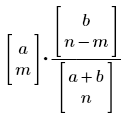Hypergeometric Distribution
The following functions are associated with the hypergeometric equation:

The parameters m, n, a, and b are integers satisfying max{0, n − b} ≤ m ≤ min{n, a}, and 0 for m elsewhere.
• dhypergeom(m, a, b, n)—Returns the probability density for the hypergeometric distribution.
• phypergeom(m, a, b, n)—Returns the cumulative probability distribution.
• qhypergeom(p, a, b, n)—Returns the inverse cumulative probability distribution for probability p.
• rhypergeom(m, a, b, n)—Returns a vector of m random numbers having the hypergeometric distribution.
Arguments
• m, n, a, b are integers, where 0 ≤ m ≤ a, 0 ≤ n − m ≤ b , 0 ≤ n ≤ a + b. To allow integration and other operations over these arguments, values outside of the stated range are allowed, but they produce a 0 result.
• p is a real probability, 0 ≤ p ≤ 1.
• All arguments are unitless numbers.
In previous versions of PTC Mathcad Prime, units were allowed in the arguments of the random numbers distribution function. Starting with PTC Mathcad Prime 10.0.0.0, all arguments are unitless. This change was made to align the behavior of the random distribution function to other probability distribution functions. If your arguments used units, make sure to adjust them for maintaining a correct scaling. |